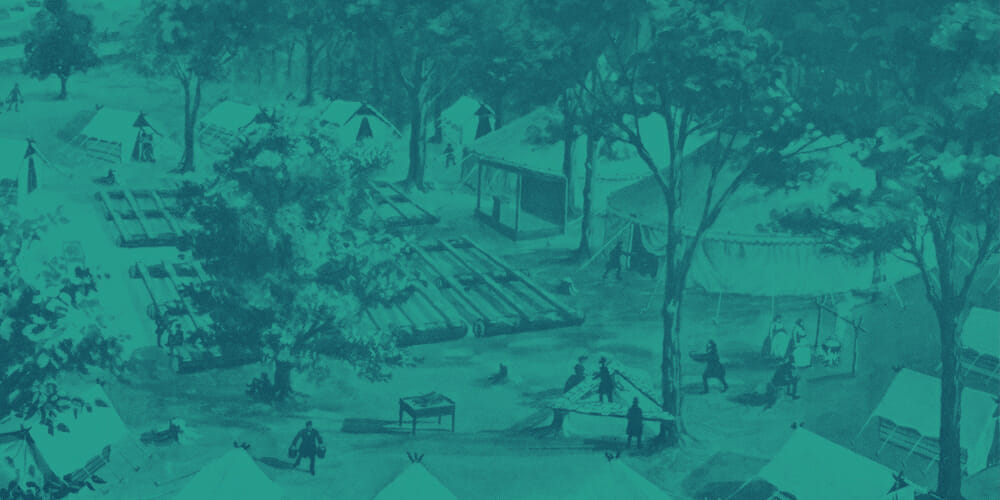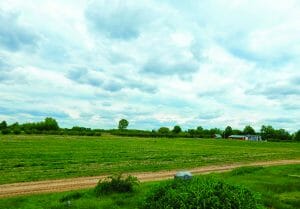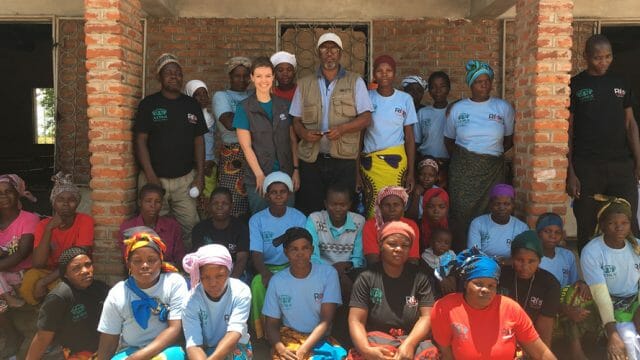Just a week before Christmas 1866, James White, weakened from a stroke he had suffered just 16 months before, was not recovering the […]

Just a week before Christmas 1866, James White, weakened from a stroke he had suffered just 16 months before, was not recovering the way his wife, Ellen, believed he should. James had received hydrotherapy treatments and other natural remedies at Our Home on the Hillside, a health institution run by Dr. James Jackson in Dansville, New York, United States, but Ellen was not content with his results. Fearing that he would never fully recover while remaining inactive, Ellen chose to take a speaking tour of what she considered “northern Michigan,” with James in tow.
Ellen wrote, “In order to obtain means for our journey, I pulled up my rag carpets and sold them. . . . With the money secured by the sale of the carpets, I bought a covered wagon, and prepared for the journey, placing in the wagon a mattress for Father to lie on.”1

Accompanied by their son Willie, the Whites left their home in Battle Creek in the middle of a snowstorm (“the severest cold of winter,” as Ellen White wrote).2 Their destination was Wright, Michigan, a small farming community on the western side of the state—95 miles from Battle Creek. It didn’t seem like a wise decision, traveling so far with James in such feeble condition. Ellen wrote, “My husband stood the journey of ninety miles much better than I feared, and seemed quite as well when we reached our destination as when we left Battle Creek.”3
- H. Root had invited them to stay with him and his family on his farm. Wright was like a second home for the Whites in their travels around Michigan, and their love for the church members, as well as the hospitality they received, made it the perfect place for the next stage of James’s recovery.
Ellen was adamant that James should exercise every day. “Daily my husband went out for a walk. In the winter a terrible snowstorm came, and Father thought he could not go out in the storm and snow. I went to Brother Root and said, ‘Brother Root, have you a spare pair of boots?’
“‘Yes,’ he answered.
“‘I should be glad to borrow them this morning,’ I said. Putting on the boots and starting out, I tracked a quarter of a mile in the deep snow. On my return, I asked my husband to take a walk. He said he could not go out in such weather. ‘Oh, yes, you can,’ I replied. ‘Surely you can step in my tracks.’ He was a man who had great respect for women; and when he saw my tracks, he thought that if a woman could walk in that snow, he could. That morning he took his usual walk.”4
James’s health began to improve steadily, and after 18 months of tender care, along with a healthy dose of gentle coercion to get back into the pulpit and preach, he recovered.
Adventist Beginnings
Why did the Whites choose the Wright community? Was it the gracious hospitality of Farmer Root and his family? Was it the fresh, clean air? Perhaps, but more important, there was a necessary work for the congregation to do, and it was just the impetus James needed to get back to work.
Wright was a Sabbathkeeping Adventist church established three years before the Michigan Conference was formed, and five years before the General Conference was organized. In 1858 Joseph B. Frisbie came to Wright, the “edge of the frontier,” to hold a series of evangelistic meetings. They were well attended, in spite of resistance from local clergy. After starting the series in the local schoolhouse, Frisbie was forced to find a new venue. One of the township supervisors offered the use of his barn, and the meetings continued. At the close of his seminar, enough were baptized to start a new church.
When the Whites arrived in the winter of 1866, however, Ellen wrote, “We found this church in a very low condition. With a large portion of its members the seeds of disunion and dissatisfaction with one another were taking deep root, and a worldly spirit was taking possession of them. And notwithstanding their low state they had enjoyed the labors of our preachers so seldom that they were hungry for spiritual food. Here commenced our first effective labors since the sickness of my husband. . . . We were listened to with the greatest attention. I saw that my husband was growing stronger, clearer, and more connected in his subjects.”5
The Whites spent six weeks with the Wright congregation, encouraging them through biblical teaching, instruction in health principles and dress reform, and creating a plan for systematic benevolence (giving tithes and offerings). Members confessed wrongs to one another, unity was restored, and the church flourished.
Significantly, the first organized Seventh-day Adventist camp meeting was held in Wright, just two years after the Whites’ blustery winter journey. “At a meeting held in the Wright, Michigan, church in July of 1868, attended by James and Ellen White and Uriah Smith, the subject of camp meetings was introduced.”6 At first James suggested having a large lake states camp meeting, but it was too late in the season to plan for a wide-scale event.
The alternative was to organize smaller regional meetings: “one for western Michigan, Wisconsin, and Illinois; one for eastern Michigan, New York, and Canada; and one for southern Michigan, Indiana, and Ohio. It was decided to hold the first-named regional meeting at Wright, because it was near Lake Michigan, and Wisconsin and Illinois [believers] could easily reach it by water.”7 That first regional camp meeting was so successful that the idea of a large general camp meeting was dropped, and conference camp meetings became the standard.
Still Witnessing
Today, if you visit the Adventist church in Wright, Michigan, you will find faithful members actively involved in the mission of the church, 160 years after it was established. It is still a place where healing and restoration take place, on the grounds of the old maple grove.
1 Ellen G. White, Selected Messages (Washington, D.C.: Review and Herald Pub. Assn., 1958, 1980), book 2, p. 306.
2 Ellen G. White, Testimonies for the Church (Mountain View, Calif.: Pacific Press Pub. Assn., 1948), vol. 1, p. 103.
3 Ibid., p. 104.
4 E. G. White, Selected Messages, book 2, p. 307.
5 E. G. White, Testimonies, vol. 1, p. 570.
6 A. W. Spalding, Origin and History of Seventh-day Adventists (Washington, D.C.: Review and Herald Pub. Assn., 1962), vol. 2, p. 9.
7 Ibid., pp. 9, 10.
Bernard Andersen is an emeritus board member of Adventist Heritage Ministry and head elder of the Seventh-day Adventist Church in Wright, Michigan. Beth Thomas is a freelance editor and writer living in Laurel, Maryland, United States.








